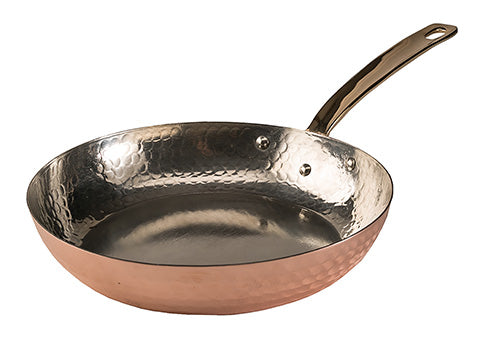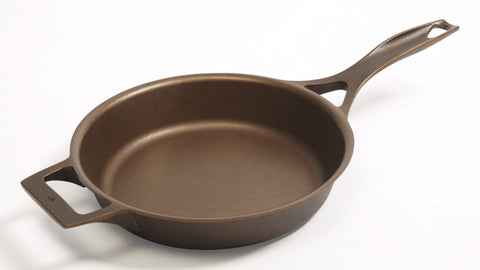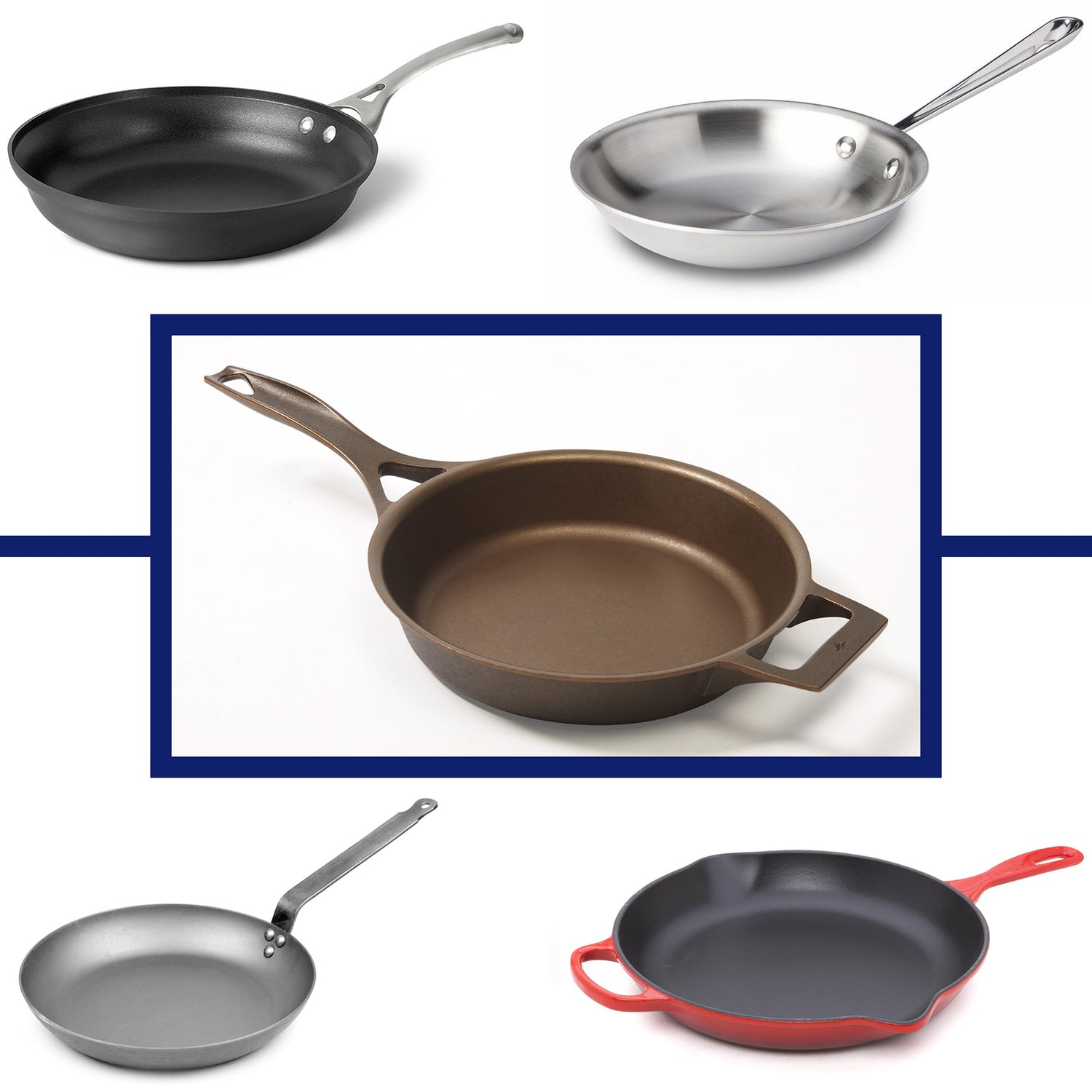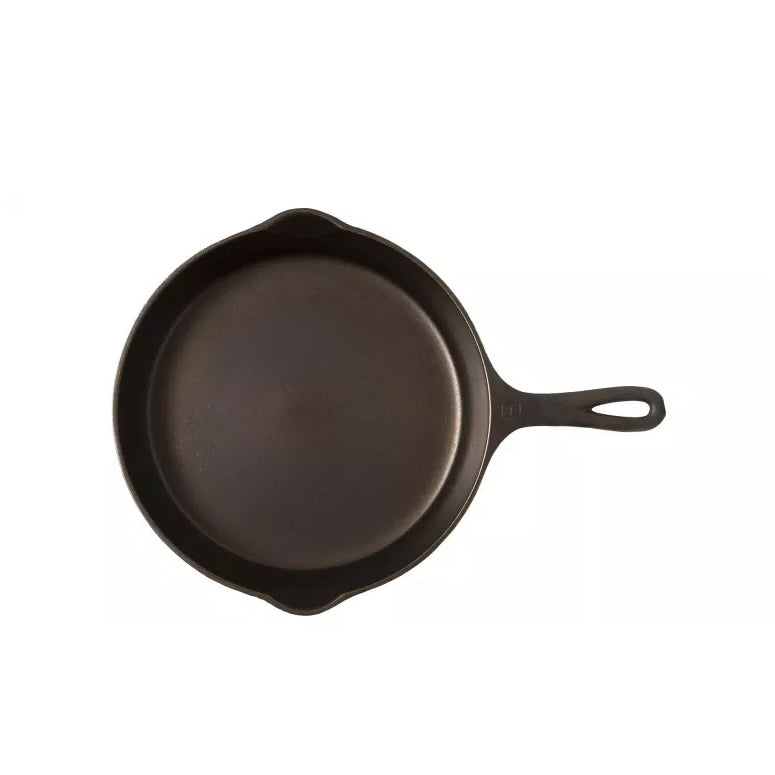As a producer of cast iron cookware, we get a lot of questions about why cast iron is different than other cookware options out there, so we wanted to put together a guide for anyone looking to learn more about the pros and cons of different types of cookware.
The Five Common Cookware Metals
There are five different metals that are used to make pretty much all the cookware on the market. They are:
- Aluminum
- Copper
- Stainless steel
- Cast iron
- Carbon steel
We’ll go through them one by one, show some examples, and talk about the pros and cons of each.
What to Look for in Your Cookware
When it comes to making a purchase, whether you're looking for premium cookware or are on more of a budget, here are some important factors to keep in mind:
Heat Distribution
One of the most important qualities of a cookware material is its ability distribute heat. Cookware that distributes heat effectively will cook more evenly, with fewer hot spots. A hot spot occurs when the heat applied to the bottom of the pan isn’t properly distributed throughout the material, causing the area of the cooking surface directly above the heat source to be much hotter than the areas around it.
Heat Retention
Another important factor in choosing a cookware material is heat capacity, which is the material’s ability to retain heat. This is a bit harder to quantify, because heat capacity is a function of mass, which means that a thicker, heavier pan will retain heat longer. But we’ll talk about weight and material thickness more in another post.
Induction Compatible
Induction cooking is becoming more and more popular, and the induction-compatibility of your cookware is something to keep in mind if you currently have or are considering purchasing an induction range or countertop cooker. For cookware to work on an induction cooktop it must be comprised of, or contain, a ferromagnetic metal such as cast iron or stainless steel.
Reactivity
We’re going to mention reactivity for each of these cookware metals--specifically the way in which the cookware reacts (or doesn’t react) with acidic foods. By reacts, we mean that acidic foods will actually eat into the metal, which not only pits the surface of the cookware, but leeches some of that metal into whatever you’re cooking.
Aluminum
Let’s talk about aluminum first, which is one of the most popular materials these days for a frying pan. Aluminum is lightweight, cheap and very good at distributing heat. It doesn’t retain heat particularly well though, so the temperature will fluctuate as food is added to a hot pan. It’s also the softest metal on our list, so it will scratch and dent pretty easily.
The main issue with aluminum, and the reason that you never see bare aluminum cookware, is its reactivity with acid. For this reason, aluminum cookware is always coated to provide a barrier between the metal and your food.
The pan pictured below is anodized on the outside, which helps with the durability. The inside of the pan is coated with PTFE (polytetrafluoroethylene), commonly referred to by its branded name Teflon. These coatings are marketed as non-stick because, like the name says, it’s difficult for anything to adhere to them, which makes cooking certain foods much easier.
The issue with any coating, but PTFE in particular, is that it’s not very durable. A coating like this one can easily be scratched off with a metal utensil, and as soon as that happens, this pan should be disposed of. So even if you’re careful and don’t abuse it, you can expect to replace a pan like this every couple years.
Another potential issue with a coating like this one is the possibility of health risks. We say possibility because there isn’t a consensus on the subject, but some consumers are concerned that these coatings may be harmful or toxic under certain conditions.
Since aluminum is nonferrous, which means it doesn’t contain any iron, it can’t be used on an induction range by itself. So as induction ranges have gotten more popular, manufacturers have started applying a stainless steel disc to the bottom of the pan. Since steel is ferrous, an aluminum pan with this disc can be used for induction cooking.
Copper
Copper isn’t as popular as aluminum for a couple reasons. Even though it’s excellent at distributing heat, the best of the five metals on our list, it’s heavy and very expensive. Unlike aluminum, copper is extremely dense, which makes it durable and long-lasting.
Copper suffers from the same shortcomings as aluminum: it can’t be used on an induction range and it’s reactive with acidic foods. Because of this, copper is traditionally lined with tin or stainless steel like in the picture below, which provides a barrier the same way a non-stick coating does. This lining process is called cladding, which we’ll talk about more later on.

On top of the above issues, copper will oxidize if left exposed. Similar to the way iron oxides to form rust, copper will turn green like the Statue of Liberty or an old penny. To avoid this, exposed copper either needs to be polished regularly, or sealed with some kind of lacquer.
Stainless Steel
Stainless steel is a ferrous metal; it’s about 70 to 75 percent iron, so it can be used on an induction range. It’s not quite as dense as copper, but it’s still very durable. It doesn’t rust or oxidize so it’s easy to maintain. Stainless steel isn’t great at releasing food, which means that certain foods may get stuck and burnt if you’re not careful.
The biggest selling point of stainless steel is that it is resistant to acid. It won’t react with acidic foods the way aluminum or copper will, so it doesn’t need to be coated with anything. The problem is that it’s terrible at distributing heat, the worst of the five we’re looking at. It’s such a poor thermal conductor that stainless steel is basically unusable for cookware by itself.
The way manufacturers have worked around this is to combine it with a superior thermal conductor like aluminum. This is accomplished by fastening a disc of aluminum to the bottom of the pan, or by cladding the aluminum and steel together. Cladding is done by taking sheets of different metals and sandwiching them together before forming the material into a pan shape. This example pictured below is the most popular clad configuration and has 3 layers: stainless steel, aluminum, and stainless steel again. Some clad cookware has 5 or even 7 layers, alternating stainless with more thermally conductive metals like aluminum or copper.
Clad stainless steel cookware is effective at fixing the shortcomings of both materials (the reactivity of aluminum and the poor thermal conductivity of steel), but it’s usually expensive. The heat retention properties of the final pan depend on the composition. The example pictured above has an aluminum core, which doesn’t retain heat particularly well.
Cast Iron
Cast iron is one of the oldest cookware materials and it’s unique for a couple reasons. In terms of construction, cast iron is the only one on our list that is traditionally made in one piece, which means there are no joints or seams. In general, cast iron is the most durable cookware because of its construction, as well as the strength and thickness of the material. It has the same density as stainless steel even though it has more iron in its composition, about 85 or 90 percent.
Contrary to popular belief, cast iron is not great at distributing heat. It’s better than stainless steel or carbon steel, but not as effective as aluminum or copper. The area where cast iron shines is its ability to retain heat. Once it gets hot, it stays hot, more than any other option on our list. For this reason, cast iron works best if it’s been preheated before cooking. It’s also great at radiating that heat, but that’s a topic for another post. A common complaint about cast iron is the weight. Cast iron cookware is generally thicker and heavier than other cookware options but this additional weight is functional, as it contributes to cast iron’s heat retention properties.
The majority of cast iron is produced by pouring molten iron into a mold made of sand. This mold creates a rough, sandpaper-like surface texture. One of the main differences between the various cast iron skillets on the market is whether or not this surface is smoothed out after casting. Smoother cooking surfaces, like the one found on a Stargazer skillet (pictured below), are more non-stick and easier to clean.

These smooth cast iron skillets are generally more expensive than their rough counterparts, like the one pictured below, because of the additional labor involved in the manufacturing process.

Unlike stainless steel, cast iron will rust if left exposed, and it’s reactive with acid, like aluminum and copper. There are two popular methods to correct both issues: seasoning and enameling.
Seasoning is a layer of edible fat or oil that is applied to the cookware and heated. When the oil is heated, it goes through a chemical change known as polymerization, which turns the liquid oil into a hard, solid shell. This layer of seasoning protects the iron from rust and acts as a barrier to minimize acidic reactions. Seasoning also helps the surface release food, making the cookware more non-stick. You don’t have to worry about the seasoning getting damaged or wearing out, because it can be easily re-applied at any time.
The other method of protecting cast iron is enameling. To accomplish this, the iron is coated with glass-like enamel during manufacturing, as seen in the picture below. It is very effective at protecting the iron, even better than seasoning, but the enamel adds to the weight and the cost. The other trade-off is durability. The enamel coating isn’t nearly as durable as the iron itself, and it can chip or crack as the pan gets knocked around over time.

Carbon Steel
Carbon steel is traditionally used to make woks and French-style skillets like one pictured below. The chemical composition is very similar to cast iron, so you can expect a lot of the same pros and cons.

Carbon steel has been getting some buzz in recent years from people who are looking for a lightweight alternative to cast iron. Carbon steel cookware is thinner and much lighter, so it’s easier to maneuver on the stove. The downside is decreased heat retention, since there’s less mass there to hold the heat. It’s also not very thermally conductive, so you can expect to find hot spots which will cause some foods to cook unevenly.
That’s a Wrap!
So there you have it! We could probably fill many more blog posts on the subject, but we wanted to give you an overview of the pros and cons of different types of cookware without getting too deep into it. As you can probably guess, we favor one type of cookware over all the others 😊, but there different advantages to each one. The good thing is, there’s no rule that says you have to pick only one!
Catch you next time ✌️




Leave a comment
This site is protected by hCaptcha and the hCaptcha Privacy Policy and Terms of Service apply.